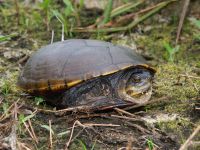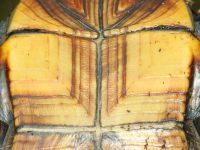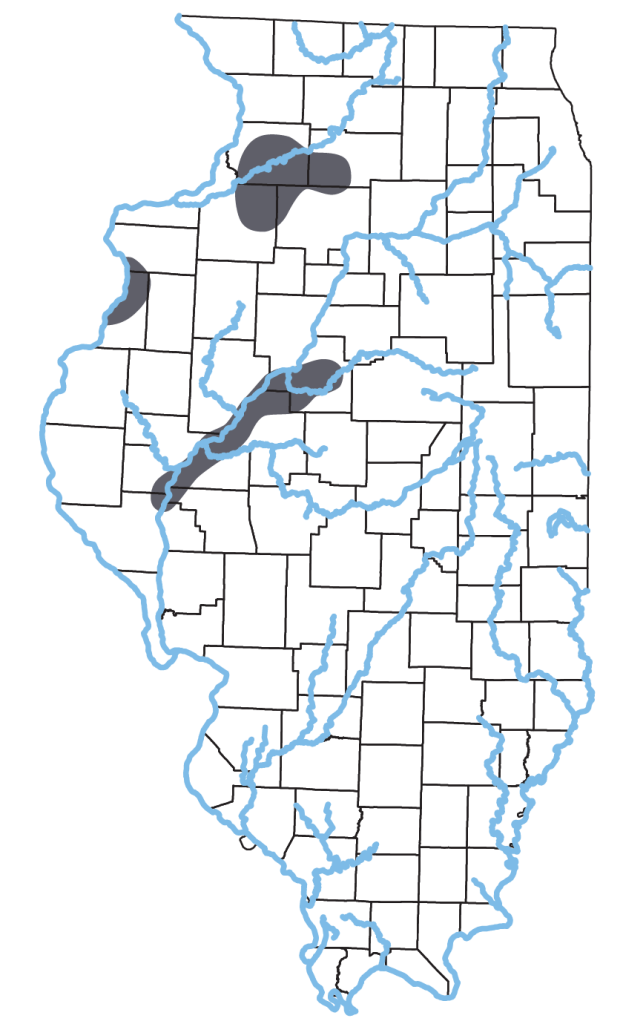Kinosternon flavescens (Agassiz, 1857)


Key Characteristics: Peaked ninth marginal scute distinctly higher than rectangular eighth in adults; triangular pectoral scutes barely in contact; plastron hinged anterior and posterior to abdominal scute.
Similar Species: Eastern Mud Turtle, Eastern Musk Turtle. See Key to Adult Turtles of Illinois for help with identification.
Subspecies: Formerly, three subspecies were recognized in the US; Illinois Mud Turtle, K. f. spooneri Smith, 1951 (Bull. Chicago Acad. Sci. 9:189-199), Arizona Mud Turtle, K. f. arizonense Gilmore, 1922 (Proc. U.S. Natl. Mus. 62(2451):1-8) and Yellow Mud Turtle, K. f. flavescens. The Arizona Mud Turtle was elevated to species and does not occur in Illinois. The validity of the Illinois Mud Turtle has been questioned by various authors (see below, “Nomenclatural History”) and its status awaits further data. Until such time, no subspecies are recognized and all Illinois populations are considered K. flavescens.

Description: Medium-sized (up to 15 cm CL) turtle with dark olive, dark brown, or black carapace and lighter plastron. Vertebral scutes 1-4 mushroom-shaped, broadest anteriorly. Male averages larger than female, with divided patch of rough scales behind knee and longer, heavier tail tipped with a claw. Young with prominent black dot on posterior part of large carapacial scutes and ninth marginal scute higher than eighth.
Habitat: Temporary to permanent ponds and backwaters of rivers in sand prairies and deep sand soils.
Natural History: Burrowed in sand most of year, moving to water a few weeks in spring and early summer. Diet consists of invertebrates, tadpoles, fish, plants. Lays 3-7 ellipsoidal, brittle-shelled eggs (ca. 25 x 15 mm) in burrows between mid-June and July. Predators include hognose snakes, raccoons, foxes, and coyotes.
Distribution Notes: Much original habitat along Green, Illinois, and Mississippi rivers has been destroyed by dredging and lock and dam construction. Current threats include lowered water tables and farming (plowing, draining, irrigating). The Lake County specimens may have been introduced. See Christiansen, et al. (2012. Declining populations of yellow mud turtles (Kinosternon flavescens) in Iowa, Illinois, and Missouri. The Southwestern Naturalist. 57 (3): 304-313) for a recent review.
Status: State Endangered.
Etymology: Kinosternon – kineo (Greek) meaning move; sternon (Greek) meaning chest, breast; flavescens – flavus (Latin) meaning yellow; escens (Latin) meaning becoming.
Original Description: Agassiz, l. 1857. Contributions to the natural history of the United States of America. Little, Brown, & Co., Boston.
Type Specimen: Syntypes, USNM & MCZ;
Type Locality: “Texas, near San Antonio; … lower Rio Grande River, Arkansas; … Camp Yuma; … Gila River “, restricted to Rio Blanco, near San Antonio, Texas by Iverson (1978. Copeia 1978(3):476-479).
Original Name: Platythyra flavescens Agassiz, 1857
Nomenclatural History: Smith (1951. Bull. Chicago Acad. Sci. 9:189-199) named the Illinois Mud Turtle, K. f. spooneri, from specimens collected in Henderson County (Illinois) State Forest. Berry & Berry (1984. Ann. Carnegie Mus. 57(7):185-206) synonomized K. f. spooneri with K. flavescens and later work using molecular markers (Serb et al. 2001. Mol. Phylogenet. Evol. 18: 149–162) failed to uncover any differences.


